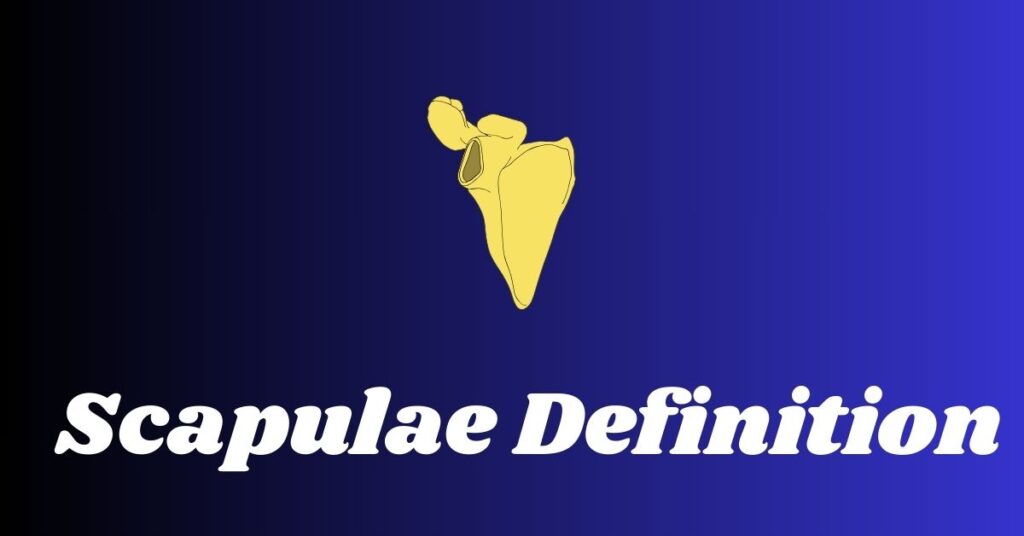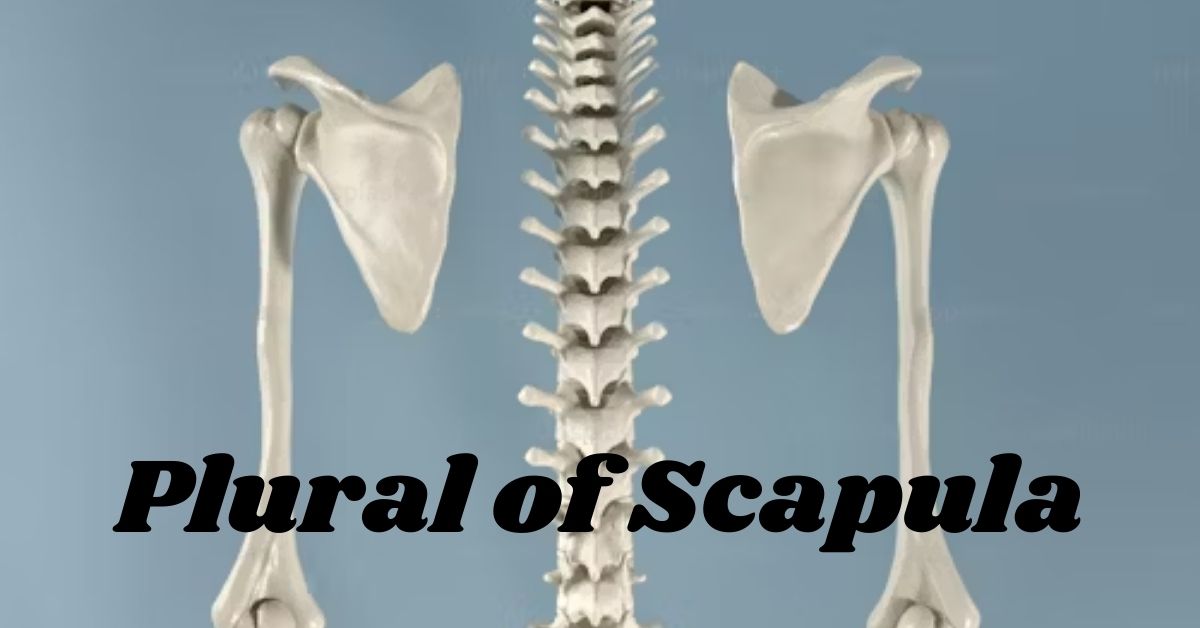What’s the Plural of Scapula? This question often arises when discussing anatomy or medical terminology. The word “scapula,” commonly known as the shoulder blade bone, has two accepted plural forms: scapulas and scapulae.
These variations reflect differences in Latin plural patterns and English pluralization rules. While “scapulas” is more common in casual language, “scapulae” is preferred in formal and technical contexts, especially among medical professionals. Understanding these distinctions is essential for accurate communication in everyday and professional settings.
Whether studying anatomical terms, analyzing a patient’s anatomy, or exploring language norms, knowing the correct plural form ensures clarity and precision in your writing and speech.
Quick Summary
“Scapula” refers to the shoulder blade bone, an essential part of shoulder anatomy. When it comes to the plural form, you can use either “scapulas or scapulae.” The choice often depends on your audience and the context in which you are speaking or writing.
Understanding these differences can enhance your communication, especially in formal contexts like healthcare or education.
Understanding Scapulas or Scapulae

The word “scapula” originates from Latin, where it means “shoulder blade.” In English, we often encounter two plural forms: “scapulas” and “scapulae.” The term “scapulae” follows Latin plural patterns, which is common in medical contexts.
On the other hand, “scapulas” aligns with more straightforward English pluralization rules. In everyday conversation, you might hear both forms, but medical professionals often prefer “scapulae” for its precision.
Origins of the Word “Scapula”
The term “shoulder blade” dates back to the 1570s and comes from the Modern Latin word “scapula,” which means “the shoulder.” The plural form, “scapulae,” refers to multiple shoulders or shoulder blades.
This term may have originally described tools like spades or shovels because of their similar shape. Its roots trace back to the Proto-Indo-European word *skap-, meaning “to cut” or “scrape,” linking it to ancient uses of animal shoulder blades.
Some Nouns Ending with “-la” and Their Plurals
Many English words end with “-la,” and their plural forms can vary significantly. For instance, consider the following examples:
| Singular | Plural |
| Formula | Formulae or Formulas |
| Nebula | Nebulae or Nebulas |
| Papilla | Papillae or Papillas |
| Scapula | Scapulae or Scapulas |
These examples illustrate how Latin noun rules influence pluralization in English. While some words shift to “-ae,” others may simply add an “-s.” This variability is a reflection of both linguistic conventions and the evolution of the English language.
What is Scapula?

The scapula is a triangular bone located in the upper back, commonly known as the shoulder blade. It plays a crucial role in connecting the arm to the body and facilitating movement.
The scapula provides attachment points for several muscles that control arm mobility and stability. Understanding its anatomy is vital for healthcare professionals conducting a scapular assessment during a medical examination.
Plural of Scapula
When discussing the plural of scapula, it’s essential to recognize that both “scapulas” and “scapulae” are correct. However, their usage may differ based on context.
In formal settings like medical reports or academic papers, you might see “scapulae” used more frequently due to its adherence to classical language patterns. In contrast, casual conversations may lean towards “scapulas,” as it feels more accessible.
Usage of “Scapulas” in a Sentence
To illustrate how to use “scapulas,” consider these examples:
- During the physical examination, the doctor carefully assessed the alignment of the patient’s scapulas to ensure proper shoulder function.
- The trainer emphasized the importance of strengthening the muscles around the scapulas to improve overall arm mobility.
- In anatomy class, we learned how injuries to the scapulas can affect a person’s range of motion and daily activities.
- The physical therapist designed a rehabilitation program focused on stabilizing the scapulas after the patient’s shoulder surgery.
- Many athletes benefit from exercises that target their scapulas, enhancing their performance in sports that require upper body strength.
Synonyms of Scapula
While there aren’t many direct synonyms for scapula due to its specific anatomical reference, related terms include:
- Shoulder blade
- Scapular bone
- Triangular bone
- Arm connector
- Shoulder girdle
- Glenoid cavity (related structure)
- Acromion (part of scapula)
- Clavicle (collarbone)
- Humerus (upper arm bone)
- Rotator cuff (muscle group connected)
These terms help expand vocabulary when discussing shoulder anatomy and related concepts.
Pluralization Rules for Words Ending with “-la”
Words ending in “-la” typically follow specific pluralization rules. Some change to “-lae” in the plural form, reflecting traditional Latin usage, such as “scapula” to “scapulae.” Others simply add an “-s,” resulting in forms like “formula” becoming “formulas.” Understanding these rules helps maintain accuracy in language.
-la to -lae
Some nouns ending in “-la” change their endings to “-lae” when pluralized. This rule follows traditional Latin-derived plurals, which maintain their classical roots even as they adapt to English usage.
-la to -las
Other nouns simply add an “-s” for their plural form, reflecting standard English pluralization rules. This approach is more straightforward and often preferred in everyday language.
Scapulae Definition

“Scapulae” refers to the plural form of “scapula,” which is commonly known as the shoulder blade. Each scapula is a flat, triangular bone located at the back of the body, playing a crucial role in connecting the upper limb to the trunk.
The scapulae articulate with the humerus and clavicle, forming important joints that enable arm movement. Understanding the anatomy of the scapulae is essential for medical professionals, as they are key components in assessing shoulder function and mobility..
Usage Examples of “Scapulae” in Sentences
To see how “scapulae” fits into context, consider these sentences:
- The surgeon discussed the patient’s scapulae during the consultation.
- Observing the scapulae helps assess arm mobility.
- The physical therapist focused on strengthening the muscles around the scapulae.
- Injuries to the scapulae can impact overall shoulder function.
- The anatomy textbook illustrated various conditions affecting scapulae.
These examples highlight how using “scapulae” conveys precise information about shoulder anatomy.
Side-by-Side Comparison: Scapulas or Scapulae
| Feature | Scapulas | Scapulae |
| Form | Plural of scapula | Plural of scapula |
| Usage Context | Common in casual language | Preferred in formal contexts |
| Origin | Follows English plural rules | Adheres to Latin plural patterns |
| Example Sentence | “The trainer focused on the scapulas during the workout.” | “The doctor examined the patient’s scapulae for any abnormalities.” |
Exceptions to These Pluralization Rules
While many words ending in “-la” follow standard pluralization rules, some exceptions exist. For instance, certain nouns may remain unchanged when pluralized, such as “sheep.” Additionally, irregular plural forms do not conform to typical patterns, leading to variations like “children.”
Recognizing these exceptions enhances our understanding of language norms and helps ensure accurate communication in both casual and formal contexts.
Singular and Plural Same
Some words remain unchanged when pluralized, such as “sheep.” These exceptions challenge our understanding of typical plural conventions but are part of English’s rich linguistic tapestry.
Irregular Plural Forms
Certain nouns have irregular plural forms that do not follow standard rules at all, like “children.” Recognizing these irregularities enhances our grasp of English grammar patterns.
Words with English Plurals
Many words follow straightforward rules for forming plurals by simply adding an “-s.” This characteristic makes them easier for learners and speakers alike.
Words Ending in “-ula”
Words ending in “-ula,” like “formula,” can take on various plural forms depending on their origin and context some may change to “-ae,” while others adopt an “-s.“
Everyday Usage Examples
In casual conversations about health or fitness, you might hear both terms used interchangeably without much thought given to their differences. For example, one might say: “I’ve been working on strengthening my scapulas,” while another could state: “
The therapist mentioned that my scapulae were misaligned.” Both statements convey similar ideas but cater to different levels of formality.
Examples of Scapula in Context

In clinical settings, accurate terminology is vital. For instance, a doctor might say, “Both scapulae show signs of strain after the patient’s injury.” In a fitness class, an instructor could mention, “Strengthening your scapulas will improve your shoulder stability.”
These examples illustrate how using “scapulae” provides precise information about shoulder anatomy and function, making it easier to communicate effectively in medical and everyday discussions.
Scapula: The Singular
In singular form, you might say: “The doctor pointed out my left scapula during the examination.” This sentence highlights one specific shoulder blade’s importance during a medical check-up.
Scapulae: Plural of Scapula
Using the plural form: “The radiologist noted abnormalities in both scapulae.” Here, it emphasizes multiple shoulder blades being analyzed for potential issues.
Scapulas: Plural of Scapula
In a more casual setting: “The trainer explained how different exercises target my scapulas.” This usage feels approachable while still being informative about fitness practices.
More Article: Plural of Thorax: Thoraxes or Thoraces
FAQs: Plural of Scapula
What is the plural form of scapula?
The plural form of “scapula” can be either “scapulas vs scapulae,” with both being correct depending on the context.
Is it the scapula or the scapulae?
You can use either “scapulas” for casual contexts or “scapulae” for formal and medical settings, as both are accepted plural forms.
Is levator scapulae plural?
Yes, “levator scapulae” is plural, referring to the muscles that elevate the scapula; the singular form is “levator scapula.”
Conclusion
Understanding what’s the plural of scapula is essential for clear communication, especially in medical and anatomical contexts. Both “scapulas” and “scapulae” are correct, but their usage varies based on formality and audience.
While “scapulas” fits casual conversations, “scapulae” is preferred in professional settings. By recognizing these distinctions, you can enhance your language precision and effectively convey information about shoulder anatomy.
Whether discussing a patient’s anatomy or engaging in everyday dialogue, knowing the appropriate term ensures clarity and accuracy.
Related Post: Paradox vs Juxtaposition: Key Differences You Need to Know

